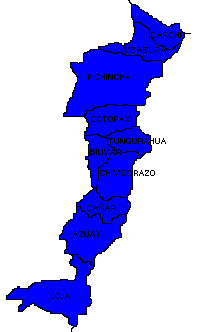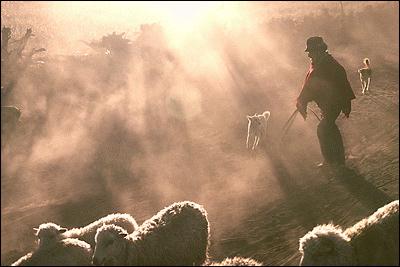Sierra
 People who have never visited Ecuador often picture it as a land of steamy jungles astride the Equator, bordered by the Pacific Ocean. They are unaware that a large area is Andean Sierra, dominated by a range of towering volcanoes6 and highland valleys that form a significant temperate ecological region.
People who have never visited Ecuador often picture it as a land of steamy jungles astride the Equator, bordered by the Pacific Ocean. They are unaware that a large area is Andean Sierra, dominated by a range of towering volcanoes6 and highland valleys that form a significant temperate ecological region.
Five million year ago, at the beginning of the Pliocene period, the mountain range now named the Andes appeared, dividing Ecuador into two low forested plains and a narrower, intermediate band bordered by the "Avenue of the Volcanoes"7. Herein developed an indigenous flora and fauna adapted to low temperatures, strong winds, intense ultraviolet radiation, rain, hail, snow and high altitudes.
Ecuador is divided from north to south by the Andean Cordillera, forming three important profile area groups: the Eastern Cordillera, the InterAndean region with various basins and valleys, and the Western Cordillera.
The rainy season in this area lasts from October to May, with an average annual temperature range of 11.5° to 18° C. The daily variation, however, can be extreme with very hot days and quite cold nights. Yet, some often refer to the Sierra climate as "eternal spring".

The Sierra's climatic conditions, as well as recent volcanic activity, has produced peculiar and interesting plant formations that distinguish the area's beautiful landscapes called the páramo. One tenth (2'500.000 H.) of the Ecuadorian land area is covered with paramos or high altitude dry vegetation. Situated between 3,500 and 4,500 m. above sea level, this is a habitat ideal for condors, caracaras, deer, llamas, vicuñas, multicolored flowers and hummningbirds.
The Andean paramos are covered with gramineous plants, creeping, spongey herbs, paramo grasses, everlasting as Chuquirahua and roselike flowers. The northern paramos, especially near El Angel, are noted for their giant frailejones (Espeletia), while the flanks of the Cordillera are covered with heaths, trees full of lichens and moss, and shrubs that serve as a refuge for pumas, tapirs and bears.
<<<<< Costa | Oriente >>>>>
|